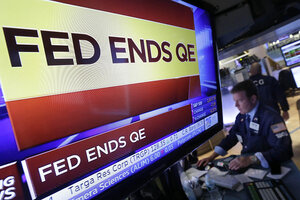Fed says goodbye to historic bond buying program: 4 key takeaways
The Federal Reserve announced the end of its landmark quantitative easing program Wednesday, and investors found the Fed's overall policy statement more hawkish than expected. Here are the highlights of today's Federal Reserve policy statement.

A television screen on the trading floor of the New York Stock Exchange shows the decision of the Federal Reserve, Wednesday, Oct. 29, 2014. The Fed plans to keep a key interest rate at a record low to support a US job market that's improving but still isn't fully healthy. The Dow fell 31 points for the day.
Richard Drew/AP
It’s the end of an historical era for the Federal Reserve.
As widely expected, the Fed announced Wednesday the end of the third phase of its landmark quantitative easing program, halting the final $15 billion in bond purchases of a multitrillion-dollar program started in late 2008 to kick-start the economy in the wake of the 2008-09 crash. But investors found the general tone of the Fed’s statement a little more hawkish than expected. Stocks ended slightly lower Wednesday in response: The Dow fell 31 points, and the S&P 500 slid 2.75 points.
Besides the QE3 news, the Fed’s statement held a few closely watched changes in its position on the labor market, inflation, and its timeline for raising interest rates. Here are the highlights:
Interest rates will remain low “for a considerable time”
The phrase, among the most-watched of the last few Fed statements, remained intact, as most analysts expected. The Fed reiterated its earlier assertion that it would maintain the current near-zero federal funds rate “for a considerable time following the end of its asset purchase program this month.” It did, however, hint at speeding rate hikes along if data and market conditions warranted, noting, “if incoming information indicates faster progress toward the Committee’s employment and inflation objectives than the Committee now expects, then increases in the target range for the federal funds rate are likely to occur sooner than currently anticipated. Conversely, if progress proves slower than expected, then increases in the target range are likely to occur later than currently anticipated.
Analysts predict that rates will go up sometime in the middle of next year, though the exact timing is still a question mark. “Overall, today’s statement changes do not change our view that the FOMC will be raising rates in June 2015,” Barclays Research economist Dean Maki writes in an e-mailed analysis. “We think today’s statement emphasizes that tightening will proceed based on labor market progress, and external factors are only likely to interfere with that process to the extent that they seem to be slowing the labor market.”
Labor market outlook more upbeat than expected
This was perhaps the most surprising part of a mostly expected statement, as the Fed’s language on labor market conditions changed slightly to indicate a more hawkish stance. The statement cited “solid job gains and a lower unemployment rate,” and went on to say that “a range of labor market indicators suggests that underutilization of labor resources is gradually diminishing.” The stronger language gave some analysts and investors pause, and stocks fell Wednesday afternoon in response. “Indeed, the labor market has improved notably this year on a number of measures, particularly the pace of payroll growth, jobless claims, the pace of hiring, and the decline in the unemployment rate,” IHS Global Insight economist Paul Edelstein writes in an e-mail. “Yet persistently-subdued wage growth suggests that the labor market is far from overheating.”
Inflation outlook holds steady
The statement acknowledged that inflation continues to run “below the Committee’s longer-run objective,” but maintained confidence “that the likelihood of inflation running persistently below 2% has diminished somewhat since early this year.” Economists doubt that inflation will have less impact on the Fed’s future moves than the state of the labor market, however. “The interesting situation will be if the Fed is correct about the labor market but wrong about inflation,” Edelstein writes If the unemployment rate is in the low-5% range, we expect the Fed to raise interest rates even if inflation is below the 2% target, at least within limits.
Overall, a more hawkish tone
The tone shifts in the Fed’s statement led to a shift in voting for the new policy. The committee’s known hawks, Richard Fisher and Charles Plosser, voted with the majority after dissenting on several previous policies. The lone dissenter was the Fed’s most dovish member, Narayana Kocherlakota, who wanted the $15 billion a month pace in bond buying to continue.

